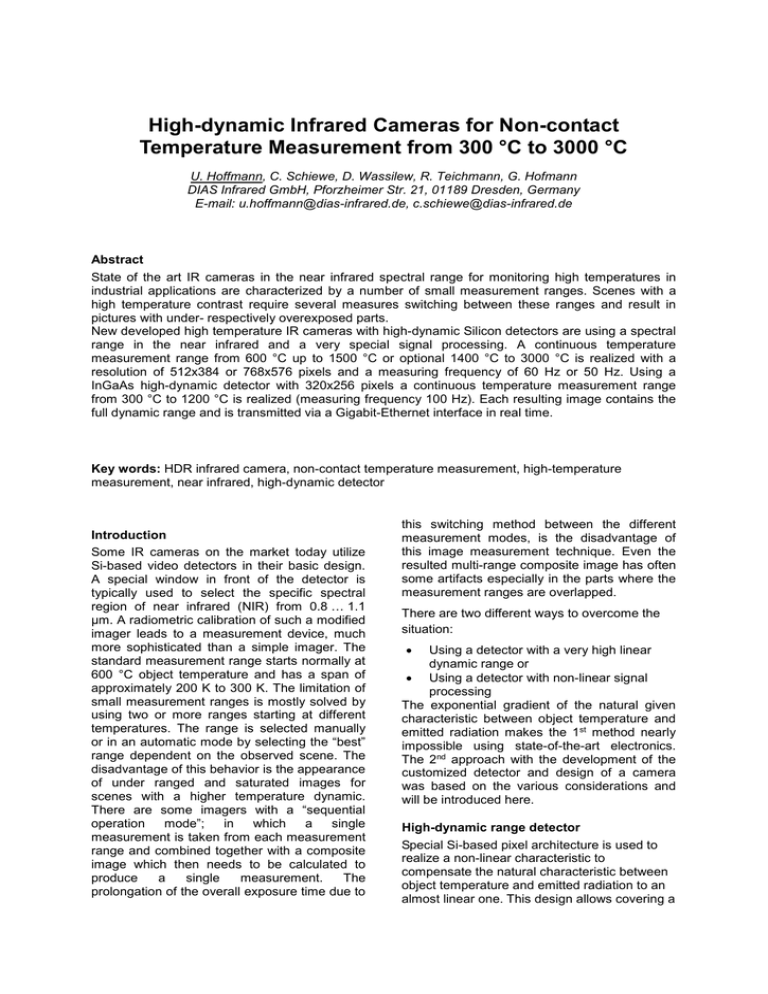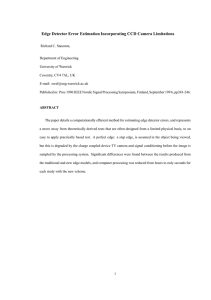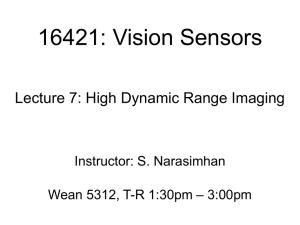High-dynamic Infrared Cameras for Non
advertisement

High-dynamic Infrared Cameras for Non-contact Temperature Measurement from 300 °C to 3000 °C U. Hoffmann, C. Schiewe, D. Wassilew, R. Teichmann, G. Hofmann DIAS Infrared GmbH, Pforzheimer Str. 21, 01189 Dresden, Germany E-mail: u.hoffmann@dias-infrared.de, c.schiewe@dias-infrared.de Abstract State of the art IR cameras in the near infrared spectral range for monitoring high temperatures in industrial applications are characterized by a number of small measurement ranges. Scenes with a high temperature contrast require several measures switching between these ranges and result in pictures with under- respectively overexposed parts. New developed high temperature IR cameras with high-dynamic Silicon detectors are using a spectral range in the near infrared and a very special signal processing. A continuous temperature measurement range from 600 °C up to 1500 °C or optional 1400 °C to 3000 °C is realized with a resolution of 512x384 or 768x576 pixels and a measuring frequency of 60 Hz or 50 Hz. Using a InGaAs high-dynamic detector with 320x256 pixels a continuous temperature measurement range from 300 °C to 1200 °C is realized (measuring frequency 100 Hz). Each resulting image contains the full dynamic range and is transmitted via a Gigabit-Ethernet interface in real time. Key words: HDR infrared camera, non-contact temperature measurement, high-temperature measurement, near infrared, high-dynamic detector Introduction Some IR cameras on the market today utilize Si-based video detectors in their basic design. A special window in front of the detector is typically used to select the specific spectral region of near infrared (NIR) from 0.8 … 1.1 µm. A radiometric calibration of such a modified imager leads to a measurement device, much more sophisticated than a simple imager. The standard measurement range starts normally at 600 °C object temperature and has a span of approximately 200 K to 300 K. The limitation of small measurement ranges is mostly solved by using two or more ranges starting at different temperatures. The range is selected manually or in an automatic mode by selecting the “best” range dependent on the observed scene. The disadvantage of this behavior is the appearance of under ranged and saturated images for scenes with a higher temperature dynamic. There are some imagers with a “sequential operation mode”; in which a single measurement is taken from each measurement range and combined together with a composite image which then needs to be calculated to produce a single measurement. The prolongation of the overall exposure time due to this switching method between the different measurement modes, is the disadvantage of this image measurement technique. Even the resulted multi-range composite image has often some artifacts especially in the parts where the measurement ranges are overlapped. There are two different ways to overcome the situation: • Using a detector with a very high linear dynamic range or • Using a detector with non-linear signal processing The exponential gradient of the natural given characteristic between object temperature and emitted radiation makes the 1st method nearly impossible using state-of-the-art electronics. The 2nd approach with the development of the customized detector and design of a camera was based on the various considerations and will be introduced here. High-dynamic range detector Special Si-based pixel architecture is used to realize a non-linear characteristic to compensate the natural characteristic between object temperature and emitted radiation to an almost linear one. This design allows covering a wide dynamic scene of over 120dB. The detector dimensions including the pixel quantity are derived from the available optics: We are using two detector arrays with 768 by 576 active elements and 512 by 384 elements. The detector is made in a standard silicon CMOS technology and is designed for working in an extreme ambient temperature range from -40 to 125°C. An internal fixed pattern noise cancellation is built-in as numerous operational modes are used for almost any measurement task. The development and manufacturing of the detector is a precondition to enable IR cameras to measure temperatures. Therefore many different jobs had to be accomplished: • The wide ambient temperature range of the detector is mostly welcomed but there was a dependency of the signal from the detector temperature. So a compensation algorithm had to be found and realized. • The wide temperature range led to difficulties for handling the radiationtemperature characteristic in the same way as for standard devices. A new description of the characteristic was found and implemented in the measurement software. In connection with this fact the (re-)calculation of object temperatures dependent on the emissivity had to be adapted. • A non-uniformity correction of the image was necessary to fulfill the requirements regarding the picture quality. Even here a new procedure was introduced to avoid the detector generated pattern especially for low signals. • Development of a calibration method fulfilled both the requirements for accuracy and for a time saving procedure for the serial production. The final Si-based high-dynamic detectors were successfully evaluated and tested under numerous conditions. Using the same principles an InGaAs-based high-dynamic detector for the spectral range 1.4 µm to 1.6 µm was also developed. The cameras based on these detectors are described in the following section. High-dynamic IR cameras The design goal of the IR camera to be created was to serve industrial applications. It results in two versions: • • A standard model in a classic camera design consisting of optics and camera body A model with cooling jacket and air purging for the use in furnaces, utility boilers or kilns; any industrial applications where a wall separates the “hot” process from the environment The first version (Fig. 1) will be described here. The heart of the camera is the detector head covering the following functions: • Providing the detector with all necessary voltages and clocks • Data gathering inclusive averaging (user selectable) • Signal processing: non-uniformity correction and ambient temperature compensation Furthermore an independent signal evaluation is implemented. There is the possibility to define up to 8 different regions of interest (ROI), with selected shapes i.e. rectangles, circles, square etc., superimposed over the thermal image to provide the minimum, maximum and/or average temperature and up to two threshold temperatures for each region. The evaluation will be performed in real-time, the results of it can be linked to the camera outputs (digital, electrically isolated) directly. This kind of signal evaluation needs only one time programming (using a PC) and provides “stand alone” operation without the need for a connected computer. A Gigabit-Ethernet connection realizes a real-time data transfer and gives full control of the camera. Fig. 1. High-dynamic infrared cameras PYROVIEW 512N, 768N and 320N Table 1 gives a short overview about some important technical data. All three models have large continuous measurement ranges (300 °C to 1200 °C or 600 °C to 1500 °C with option 1400 °C to 3000 °C). Tab. 1: Technical data of high-dynamic IR cameras PYROVIEW (more details: www.dias-infrared.de) PYROVIEW 320N PYROVIEW 512N PYROVIEW 768N 320 x 256 pixels 512 x 384 pixels 768 x 576 pixels 300 °C to 1200 °C 600 °C to 1500 °C, optional 2400 °C to 3000 °C 600 °C to 1500 °C, optional 2400 °C to 3000 °C 1.4 µ to 1.6 µm 0.8 µm to 1.1 µm 0.8 µm to 1.1 µm 100 images per second 60 images per second 50 images per second Application examples In principle, infrared cameras are ideal for temperature measurements on hot parts that move at the same time. So there is no fixed measuring point that we could measure with a pyrometer. For the detection of hotspots IR cameras are better suited than pyrometer, since one does not know the location of the hotspot previously in general. The large continuous measurement range of the developed highdynamic IR cameras is very helpful for such applications like: • Induction heating and soldering • Brazing • Brazing with temperature profile • Annealing • Shrinking • Hardening (e.g. hardening of cutter blades) • High-temperature tempering • Forging (e.g. open die forging) • Casting (e.g. Continuous casting) • Laser welding (e.g. stainless steel tubes) • No retooling / realignment of the system required for format changes because of wide-coverage measurement at the strand outlet • Easy installation of measuring system on the machine due to compact dimensions of camera enclosures • Continuous system self-check (monitoring of camera operating temperatures, plausibility checks among cameras) • No moving mechanical components for long service life and minimum maintenance costs (filter systems etc.) • Flexible adaptation of analysis tools and storage of various parameter sets, e.g. also for R&D tasks Continuous casting Two high-dynamic IR cameras PYROVIEW 512N were used to control the secondary cooling by water sprayers up to six steel strands (Fig. 2). Fig. 3. Continuous casting (two IR cameras generate four temperature values) Fig. 2. Continuous casting (control of the secondary cooling) The software PYROSOFT-Automation calculates four temperature values for each strand (Fig. 3). These four values of interest VOI are sent to a Siemens PLC for each strand (Fig. 4). This system solution with two cameras has the following advantages: • Tested and proven system for temperature measurement at the strand outlet • Reliable measurement of even the smallest details on 3 sides of each strand, thanks to high camera resolution of 512 x 384 pixels Fig. 4. Continuous casting (system design) Electric forging of bolts This technology utilizes the energy to transform the metal through a current flow (Joule effect Q=U×I×∆t), which simultaneously heat the area to be forged and deform it. The steel is heated at 1200 ° C and electrostatic compressed. The target is to control the forging temperature during the hot bolt is moving (Fig. 5). • Different types of components are heated, thereby there are different positions of the control points • An object is heated with two generators, so it needs two regions • Two generators heat up two objects, a camera detects both regions • A region is used for control, the second region determined the end of the process if the target temperature is reached Fig. 5. Forging temperature measurement (IR images before and after compression) Induction heating and soldering In this application the high-dynamic cameras operate direct to the induction controller without a PC (Fig. 6). Many induction heating equipment’s are controlled by pyrometers but a camera solution is better if: • The hot spot changes his position during heating up the object (jumping hot spot) • The object moves, for example, by rotation or along the Inductor (moving hot spot) Fig. 6. Induction heating (system design) The project is supported by the Ministry of Economy and Energy of the Federal Republic of Germany (Zentrales Innovationsprogramm Mittelstand).


